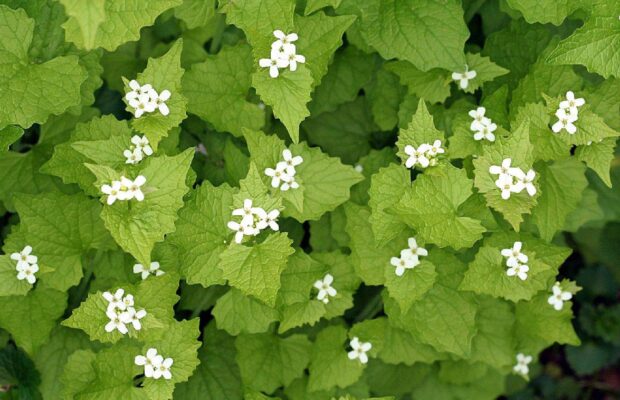Garlic mustard one of growing number of invasive species in Iowa ecosystems

Spring is a season where we all get excited for those first little blooms to pop out of the frosted grass and finally get to spend time outside. All the bright green plants growing is a sight for sore eyes after a long winter.
Sometimes, though, the beautiful green that appears is not actually something to celebrate because we are looking at an invasive species of plant that is destroying a delicate Iowa ecosystem. The dainty little flower you might have walked by in the Hartman reverse could have been a toxic plant or quick spreading invasive species. Iowa is in fact littered with all kinds of invasive species of plants.
Invasive species cause extinction of regular plants that support biodiversity in Iowa. When native plants die out or are pushed to low numbers, there will be no native food to provide for the animals that live in that area.
One of the most prolific and damaging species invading Iowa woodlands is the garlic mustard plant. It’s not what it sounds like, though. This is not a tasty garlic bud used for garlic bread. The garlic mustard plant was once native to Europe and has been spreading through North America since colonization, and it is a major threat to biodiversity in Iowa.
The plant has no natural predators or diseases, meaning it can easily thrive. To identify the garlic mustard plant, they start as clusters of leaves, then become a thin rod, growing into a flamboyant four foot tall plant with a dainty white flower on the top.
How could something so beautiful cause havoc in Iowa’s environment? Very easily and really quickly. For example, if gooseberries and wild grapes are pushed out by fast growing garlic mustard, beaver, deer, turkey, squirrels, rabbits, raccoons all lose an important food source, as none of those animals will eat garlic mustard. Those animal populations will eventually die out. There are in fact only two mammals willing to eat Garlic Mustard. According to leelanauconservancy.org, those two mammals are best for controlling Garlic Mustard plants. In Leelanau County located in Michigan, they use a rather fun and effective way to remove huge infestations of garlic mustard: herds of goats and human volunteers together. In a controlled, non-permanent fenced area of a woodland, the goats eat all the smaller tender plants that have not yet grown the billions of seeds that they produce, and then the humans pull out the larger four foot plants, disposing of them carefully in bags to burn. Then the goats and volunteers move to the next area. Very effective but time consuming. The other way is from controlled burns of areas.
To help control invasive species from altering ecosystems in Iowa, Julia Baker, a Natural Resources Extension Program Specialist from the Department of Natural Resource Ecology & Management at Iowa State University, suggests these simple actions that Iowans can take.
How can Iowans help decrease and control the spread of invasive plant species?
Here are a few things that Iowans can do to help prevent and control invasive species. Buy native plants for landscaping yards or at least avoid planting known invasive plants. I’m sure you saw in our invasive species resources on our website that several invasive plants have invaded Iowa’s woodlands after spreading from yards. People can clean their boots off before and after hiking, which is particularly useful for preventing the spread of garlic mustard. Iowans can also look for volunteer opportunities to help remove invasive plants on public land. The Iowa Department of Natural Resources, Iowa Natural Heritage Foundation, county conservation boards, and other organizations often host these events. Iowans can also learn to identify and remove invasive plants from their own property. Garlic mustard can be harvested and used for cooking so people could even get a group together to collect it, find recipes for safely consuming it, and host a meal (be sure to watch out for signs about herbicide spray before collecting).
So what can you do in Black Hawk County? Not many of us have trained goats! Though we can take the precautions and actions outlined by Julia Baker to take care of the paths we forge through the woodlands in the Cedar Valley, and cleaning our boots is one of the helpful ways to control the spread of garlic mustard seed and other invasive plants.
If you are interested in saving local woodlands, check out the volunteer opportunities at the Hartman Reserve. Tread carefully this summer!









You must be logged in to post a comment Login